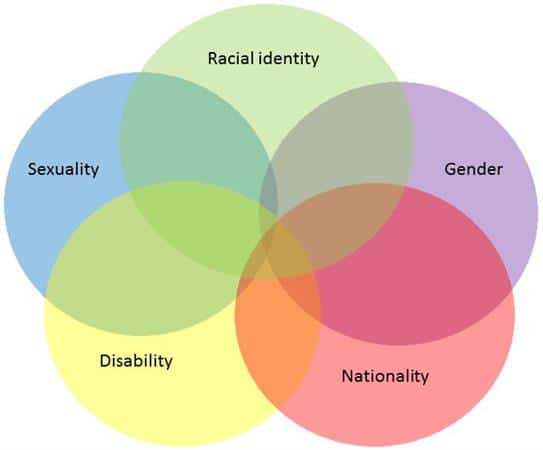Intersectionality: An Introduction
Intersectionality
First of all, let’s start with the basics, what is intersectionality?
“Intersectionality is the acknowledgement that everyone has their own unique experiences of discrimination and oppression, and we must consider anything that can marginalise people – gender, race, class, sexual orientation, physical ability, etc.” – Bridie Taylor, Womankind Worldwide: 2019.


Figure.1: A diagram showing different areas of intersectionality (2019)
What Everyone Should Know About Intersectionality
Examples of intersectionality include workplace discrimination, the gender pay gap, people experiencing homelessness, and issues relating to health.
What are the five facts everyone should know?
- The term ‘intersectionality’ surfaced in 1989, but that doesn’t mean people had not experienced the impacts beforehand.
- Intersectionality does not define a person’s value. Contrary to popular belief the aim is not to create competition or question self-importance.
- People argue this framework causes us to complicate discrimination.
- A wide array of areas is covered instead of focusing on one topic.
- Intersectionality is not the only theory.
The Facts & Figures
Example 1: Brazil is one of the many countries that occupy a sad track record for their LGBTQIA+ community. “Over 150 transgender people alone were killed in Brazil as of September 2020. This is 70% higher than in 2019, which means the country has the highest levels of violence against trans.” – OpenDemocracy: December 2020. Brazil is reportedly one of the most violent countries with the highest number of homicides and attacks against the LGBTQIA+ community.
Example 2: Covid-19 is a barrier that created inequalities, specifically relating to race. Research that investigates the impact of Covid-19 suggests that ethnic minorities were more likely to contract Covid-19 and experience more negative outcomes. “National Records of Scotland (NRS) found that deaths amongst people with Pakistani ethnicity were 3.7 times as likely to involve Covid-19 as people with White Scottish ethnicity.” – Scottish Government: March 2022. Research also indicates that ethnic minorities were more likely to be exposed to Covid-19 through work and could potentially have reduced access to healthcare.

Figure.2 Death rates involving COVID-19 by sex and ethnic group (2020)
Intersectionality in the Workplace
What does intersectionality mean for the workplace?
“Wage inequality is a massive issue, particularly for people with disabilities in the workplace. In the UK, men with disabilities from the Bangladeshi community experience a pay gap of 56% (compared with non-disabled white British men).” – World Economic Forum: 2020.

Figure.3 The gender pay gap (2020)
More action plans need to be developed within the work environment. If leadership can set aside time to establish a secure budget and plan of action to raise awareness among their employees, this organisation would be far more desirable compared to an organisation with no action plan.
More support needs to be available to those who are new to the work environment.
Young people leaving education who are neurodiverse may struggle more to launch their careers compared to fellow candidates who are not neurodiverse. “In the U.S., 85% of college graduates diagnosed with autism struggle with unemployment, but very few organisations have programs to support neurodiversity.” – Harvard Business Review: 2022.
This is why employing a strong HR team, with critical experience in DEI and mental health is an essential part of any workforce. Alongside, management and leadership teams, who have full training access available to them for developing people-orientated skills and problem-solving abilities. Workplaces need to be clear and concise by ensuring all staff know their policies and practices. Data also plays a key role; each employee must be aware of the available data and how to access it.
What Can We Do To Help?
Everyone deserves to be celebrated regardless of their sex, race, gender, etc. That’s why at Cognassist, we embrace equity, diversity, and inclusion every day. If you would like additional support or are keen to learn more about neurodiversity, please visit the Cognassist Neurodiversity library where we have a range of resources, such as; free handbooks, on-demand webinars, and a whole library to help you educate yourself and others about inclusivity.